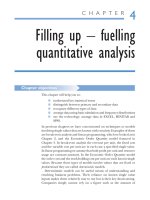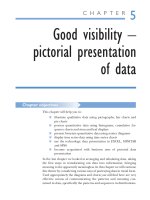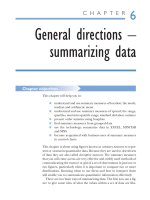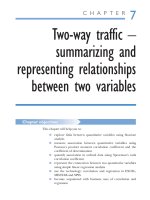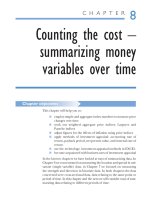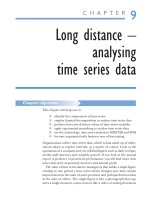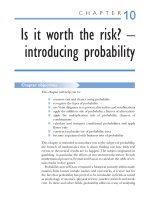Research methods for business 5th ch11
Bạn đang xem bản rút gọn của tài liệu. Xem và tải ngay bản đầy đủ của tài liệu tại đây (602.29 KB, 41 trang )
Slide 11.1
Chapter 11
Collecting primary data using
questionnaires
Saunders, Lewis and Thornhill, Research Methods for Business Students, 5th Edition, © Mark Saunders, Philip Lewis and Adrian Thornhill 2009
Slide 11.2
Saunders, Lewis and Thornhill, Research Methods for Business Students, 5th Edition, © Mark Saunders, Philip Lewis and Adrian Thornhill 2009
Slide 11.3
Use of questionnaires (1)
Definition of Questionnaires
Techniques of data collection in which each
person is asked to respond to the same
set of questions in a predetermined order
Adapted from deVaus (2002)
Saunders, Lewis and Thornhill, Research Methods for Business Students, 5th Edition, © Mark Saunders, Philip Lewis and Adrian Thornhill 2009
Slide 11.4
Use of questionnaires (2)
When to use questionnaires
• For explanatory or descriptive research
• Linked with other methods in a multiple-methods
research design
• To collect responses from a large sample prior to
quantitative analysis
Saunders, Lewis and Thornhill, Research Methods for Business Students, 5th Edition, © Mark Saunders, Philip Lewis and Adrian Thornhill 2009
Slide 11.5
Saunders, Lewis and Thornhill, Research Methods for Business Students, 5th Edition, © Mark Saunders, Philip Lewis and Adrian Thornhill 2009
Slide 11.6
Use of questionnaires (3)
Types of questionnaire
Saunders et al. (2009)
Figure 11.1 Types of questionnaire
Saunders, Lewis and Thornhill, Research Methods for Business Students, 5th Edition, © Mark Saunders, Philip Lewis and Adrian Thornhill 2009
Slide 11.7
Types of questionnaire
• The design of a questionnaire differs according to how it
is administered and in particular, the amount of contact
you have with respondents [Figure 11.1]. Selfadministered questionnaires are usually completed by
respondents. Such questionnaires are administered
electronically using the internet [Internet-mediated
questionnaires] or intranet [intranet-mediated
questionnaires], posted to respondents who return them
by post after completion [postal or mail questionnaire],
or delivered by hand to each respondent and collected
later [delivery and collection questionnaire].
•
Saunders, Lewis and Thornhill, Research Methods for Business Students, 5th Edition, © Mark Saunders, Philip Lewis and Adrian Thornhill 2009
Slide 11.8
Continued
• Responses to interviewer-administered questionnaires
are recorded by the interviewer on the basis of each
respondent’s answers. Questionnaires administered
using the telephone are known as telephone
questionnaires. The final category, structured
interviews [sometimes known as interview schedules],
refers to those questionnaires where interviewers
physically meet respondents and ask the question
face to face. These differ from semi-structured and
unstructured [in-depth] interviews [Section 10.2], as
there is a defined schedule of questions, from which
interviewers should not deviate.
Saunders, Lewis and Thornhill, Research Methods for Business Students, 5th Edition, © Mark Saunders, Philip Lewis and Adrian Thornhill 2009
Slide 11.9
Saunders, Lewis and Thornhill, Research Methods for Business Students, 5th Edition, © Mark Saunders, Philip Lewis and Adrian Thornhill 2009
Slide 11.10
Choice of questionnaire
Related factors
• Characteristics of the respondents and access
• Respondents answers not being contaminated or
distorted
• Size of sample required for analysis
• Type and number of questions required
• Available resources including use of computer
software
Saunders, Lewis and Thornhill, Research Methods for Business Students, 5th Edition, © Mark Saunders, Philip Lewis and Adrian Thornhill 2009
Slide 11.11
Data collection
Key factors
• Precisely defined questions
• Representative and accurate sampling
• An understanding of the organisational context
• Relationships between variables – dependent,
independent and extraneous
• Types of variable
Saunders, Lewis and Thornhill, Research Methods for Business Students, 5th Edition, © Mark Saunders, Philip Lewis and Adrian Thornhill 2009
Slide 11.12
Saunders, Lewis and Thornhill, Research Methods for Business Students, 5th Edition, © Mark Saunders, Philip Lewis and Adrian Thornhill 2009
Slide 11.13
Saunders, Lewis and Thornhill, Research Methods for Business Students, 5th Edition, © Mark Saunders, Philip Lewis and Adrian Thornhill 2009
Slide 11.14
Saunders, Lewis and Thornhill, Research Methods for Business Students, 5th Edition, © Mark Saunders, Philip Lewis and Adrian Thornhill 2009
Slide 11.15
Saunders, Lewis and Thornhill, Research Methods for Business Students, 5th Edition, © Mark Saunders, Philip Lewis and Adrian Thornhill 2009
Slide 11.16
Ensuring essential data are collected
Data requirements table
Saunders et al. (2009)
Table 11.2 Data requirements table
Saunders, Lewis and Thornhill, Research Methods for Business Students, 5th Edition, © Mark Saunders, Philip Lewis and Adrian Thornhill 2009
Slide 11.17
Designing the questionnaire (1)
Stages that must occur if a question is to be
valid and reliable
Source: developed from Foddy (1994)
Figure 11.2 Stages that must occur if a question is to be valid and reliable
Saunders, Lewis and Thornhill, Research Methods for Business Students, 5th Edition, © Mark Saunders, Philip Lewis and Adrian Thornhill 2009
Slide 11.18
Designing the questionnaire (2)
Assessing validity
• Internal
• Content
• Criterion – related (predictive)
• Construct
Saunders, Lewis and Thornhill, Research Methods for Business Students, 5th Edition, © Mark Saunders, Philip Lewis and Adrian Thornhill 2009
Slide 11.19
Designing the questionnaire (3)
Testing for reliability- the 3 stage process
• Test re-test
• Internal consistency
• Alternative form
Mitchell (1996)
Saunders, Lewis and Thornhill, Research Methods for Business Students, 5th Edition, © Mark Saunders, Philip Lewis and Adrian Thornhill 2009
Slide 11.20
Saunders, Lewis and Thornhill, Research Methods for Business Students, 5th Edition, © Mark Saunders, Philip Lewis and Adrian Thornhill 2009
Slide 11.21
Saunders, Lewis and Thornhill, Research Methods for Business Students, 5th Edition, © Mark Saunders, Philip Lewis and Adrian Thornhill 2009
Slide 11.22
Saunders, Lewis and Thornhill, Research Methods for Business Students, 5th Edition, © Mark Saunders, Philip Lewis and Adrian Thornhill 2009
Slide 11.23
Saunders, Lewis and Thornhill, Research Methods for Business Students, 5th Edition, © Mark Saunders, Philip Lewis and Adrian Thornhill 2009
Slide 11.24
Saunders, Lewis and Thornhill, Research Methods for Business Students, 5th Edition, © Mark Saunders, Philip Lewis and Adrian Thornhill 2009
Slide 11.25
Saunders, Lewis and Thornhill, Research Methods for Business Students, 5th Edition, © Mark Saunders, Philip Lewis and Adrian Thornhill 2009



